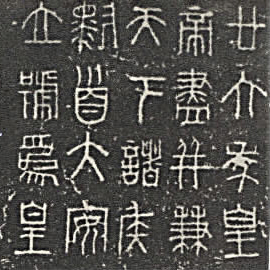Seal script
| Seal script |
|
|---|---|
 |
|
| Type | |
| Languages | Old Chinese |
|
Time period
|
Bronze Age China |
|
Parent systems
|
Oracle Bone Script
|
|
Child systems
|
Clerical script Kaishu Kanji Kana Hanja Zhuyin Simplified Chinese Chu Nom Khitan script Jurchen script Tangut script |
| Seal script | |||||||||
| Traditional Chinese | 篆書 | ||||||||
|---|---|---|---|---|---|---|---|---|---|
| Simplified Chinese | 篆书 | ||||||||
| Literal meaning | decorative engraving script | ||||||||
|
|||||||||
| Transcriptions | |
|---|---|
| Standard Mandarin | |
| Hanyu Pinyin | zhuànshū |
| Wade–Giles | chuan4-shu1 |
Seal script (Chinese: 篆書; pinyin: zhuànshū) is an ancient style of writing Chinese characters that was common throughout the latter half of the 1st millennium BC. It evolved organically out of the Zhou dynasty script, arising in the Warring State of Qin. The Qin variant of seal script became the standard and was adopted as the formal script for all of China in the Qin dynasty, and was still widely used for decorative engraving and seals (name chops, or signets) in the Han dynasty. The literal translation of its Chinese name 篆書 (zhuànshū) is decorative engraving script, because by the time this name was coined in the Han dynasty, its role had been reduced to ceremonial inscriptions rather than as a standardized script.
There are two uses of the word seal script, the Large or Great Seal script (大篆 Dàzhuàn; Japanese daiten; Korean daejeon) and the lesser or Small Seal Script (小篆 Xiǎozhuàn; Japanese shōten; Korean sojeon), the latter is also called simply seal script. The Large Seal script was originally a later, vague Han dynasty reference to writing of the Qin system similar to but earlier than Small Seal. It has also been used to refer to Western Zhou forms or even oracle bones as well. Since the term is an imprecise one, not clearly referring to any specific historical script and not used with any consensus in meaning, modern scholars tend to avoid it, and when referring to seal script, generally mean the (small) seal script of the Qin system, that is, the lineage which evolved in the state of Qin during the Spring and Autumn to Warring States periods and which was standardized under the First Emperor.
There were several different variants of seal script which developed in each kingdom independently during the warring state period and spring and autumn. The "birds and worms" script was used in the Kingdoms of Wu, Chu, and Yue. It was found on several artifacts including the Spear of Fuchai and the Sword of Goujian.
...
Wikipedia
